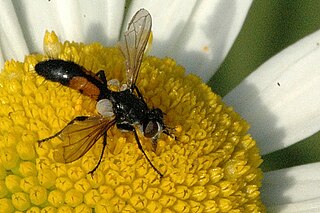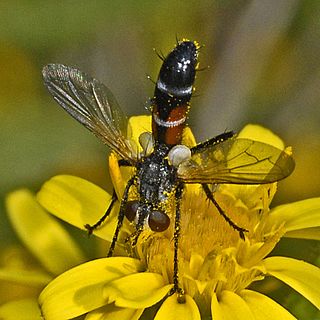
The Tachinidae are a large and variable family of true flies within the insect order Diptera, with more than 8,200 known species and many more to be discovered. Over 1,300 species have been described in North America alone. Insects in this family commonly are called tachinid flies or simply tachinids. As far as is known, they all are protelean parasitoids, or occasionally parasites, of arthropods, usually other insects. The family is known from many habitats in all zoogeographical regions and is especially diverse in South America.

Eriothrix rufomaculatus is a fly in the family Tachinidae.

Phasia hemiptera is a fly belonging to the family Tachinidae.
Actia maksymovi is a Palearctic species of fly in the family Tachinidae.

Actia pilipennis is a Palearctic species of fly in the family Tachinidae.

Tachina fera is a species of fly in the genus Tachina of the family Tachinidae. It was first described by Carl Linnaeus in 1761.

Cylindromyia auriceps is a European species of fly in the family Tachinidae.

Cylindromyia interrupta is a species of fly in the family Tachinidae.

Cylindromyia brassicaria is a species of fly in the family Tachinidae.

Phasia pusilla is a European species of fly in the family Tachinidae. Its larval hosts include species in the families Lygaeidae, Cydnidae, and Anthocoridae.

Ernestiini is a tribe of flies in the family Tachinidae.
Solieria vacua is a European species of fly in the family Tachinidae.
Anthomyiopsis nigrisquamata is a European species of fly in the family Tachinidae.

Dexiosoma caninum is a European species of fly in the family Tachinidae. In the United Kingdom, the species can most commonly be found during the summer in the south of England.

Mintho rufiventris is a European species of fly in the family Tachinidae.

Nemoraea pellucida is a species of fly in the family Tachinidae.
Siphona (Ceranthia) abdominalis is a tachinid fly in the subgenus Ceranthia of the family Tachinidae. The species was first described by Jean-Baptiste Robineau-Desvoidy in 1830.

Siphona geniculata is a Palearctic species of fly in the family Tachinidae.

Nemorilla floralis is a species of tachinid fly.

Dinera carinifrons is a species of fly in the family Tachinidae. It is found in Europe and Asia.

















